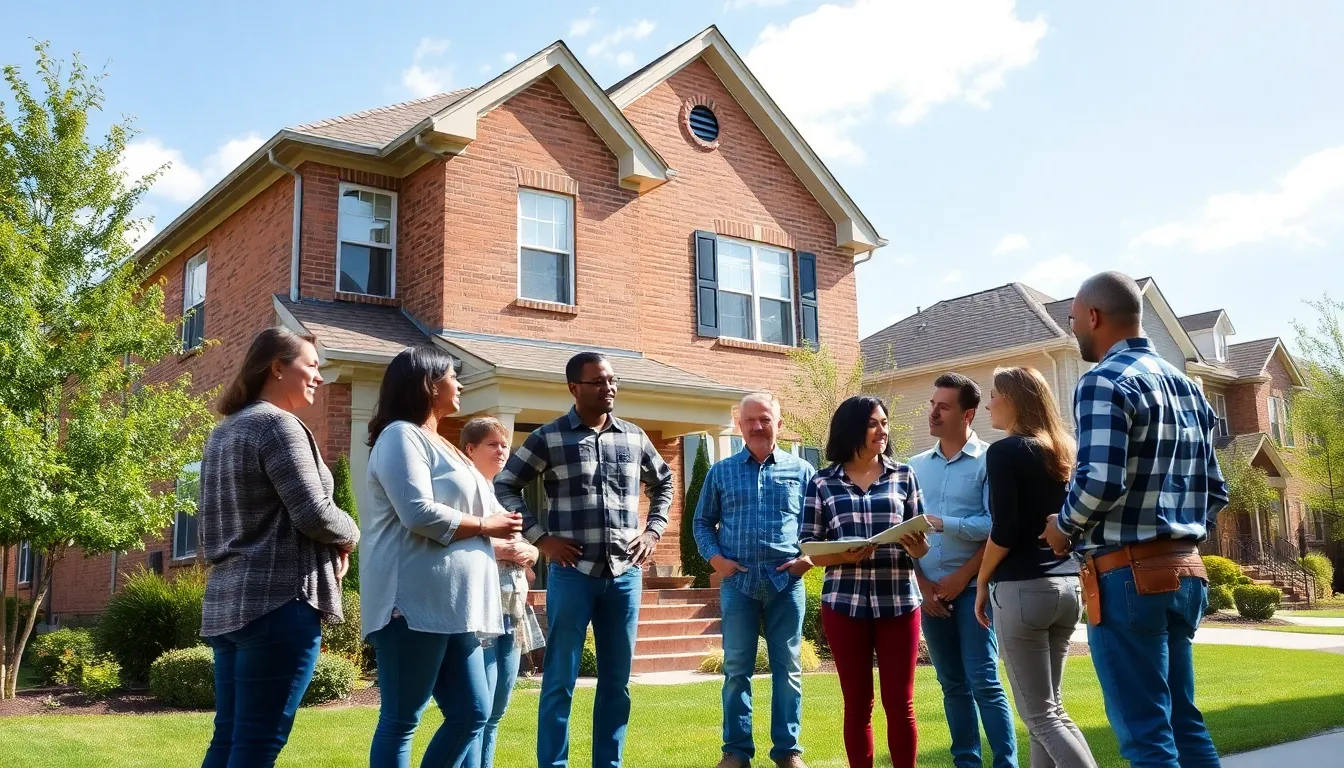When disaster strikes, the last thing anyone wants to worry about is whether their home insurance will cover the cost of rebuilding. Enter the world of home insurance replacement cost. It’s like having a safety net that catches you when life throws you a curveball—be it a tree crashing through the roof or an unexpected plumbing mishap that turns your cozy abode into a swimming pool.
Table of Contents
ToggleUnderstanding Home Insurance Replacement Cost
Home insurance replacement cost serves as a fundamental component of a homeowner’s protection strategy against financial loss during disasters. It ensures adequate coverage for repairing or rebuilding a residence without considering depreciation.
Definition of Replacement Cost
Replacement cost refers to the amount required to replace or repair damaged property using materials of similar kind and quality. This value doesn’t factor in depreciation, focusing instead on the current market price for construction materials and labor. For example, if a homeowner’s roof sustains damage, the replacement cost reflects what it takes to install a new roof, rather than the value of the old one. Understanding this concept is vital for homeowners to evaluate their insurance coverage accurately.
Importance of Replacement Cost in Home Insurance
Replacement cost carries significant importance in home insurance as it influences the policy’s effectiveness during claims. Adequate coverage protects homeowners from substantial out-of-pocket expenses after a loss incident, such as fire or flooding. A policy based on replacement cost ensures that rebuilding occurs without financial strain. To emphasize, many insurance experts advise securing coverage near current rebuilding costs to avoid underinsurance. Additionally, fluctuating construction prices underscore the necessity of regular policy evaluations to align coverage with market conditions.
Factors Affecting Home Insurance Replacement Cost

Various factors influence the replacement cost of home insurance. These elements impact how much coverage is necessary to fully protect a homeowner’s investment.
Home Value and Location
Home value significantly affects replacement cost. Higher home values often lead to increased rebuilding expenses. Location also plays a role, especially in areas prone to natural disasters like floods or earthquakes, which can increase premiums. The local construction market directly influences costs. When materials are scarce or labor is expensive in a particular region, insurance premiums can rise. Additionally, the proximity to fire services impacts risk assessment and, consequently, insurance rates.
Building Materials and Construction Type
The type of construction influences replacement costs as well. Homes built with high-quality materials generally incur higher insurance costs because they require more expensive repairs. For instance, brick structures may have different repair costs compared to those made of wood. Unique architectural features or custom finishes can also add to expenses. Older homes may present significant challenges for insurance underwriting due to outdated methods or materials. Insurers consider all these elements when determining the overall replacement cost.
Calculating Home Insurance Replacement Cost
Calculating home insurance replacement cost requires careful evaluation of various factors to ensure accurate coverage.
Assessment Methods
Homeowners can use several methods to assess replacement costs effectively. Professional appraisals provide an expert opinion on the property’s current value. Creating a detailed inventory of home contents also helps. This inventory should include the age and condition of items. Additionally, homeowners can research local construction costs through online calculators or local estimates. Engaging with a licensed insurance agent offers valuable insight tailored to specific areas. Insurers may also provide cost estimates based on current market trends and materials. Gathering this information ensures adequate coverage against potential losses.
Common Miscalculations to Avoid
Homeowners often make common miscalculations that impact replacement cost accuracy. Underestimating home square footage frequently leads to lower coverage figures. Not factoring in unique home features, like custom build-ins, creates further discrepancies. Assuming depreciation affects replacement cost can also yield misleading figures. Coverage should instead reflect rebuilding costs using current material prices. Ignoring local construction trends results in outdated assessments and insufficient coverage. To avoid these pitfalls, homeowners must regularly evaluate their policies and update them as necessary. Staying informed about regional market changes ensures proper alignment with actual rebuilding costs.
Benefits of Knowing Your Home Insurance Replacement Cost
Understanding home insurance replacement cost offers vital advantages for homeowners. These benefits enhance both financial security and peace of mind.
Financial Security in Case of Loss
Knowing your home insurance replacement cost strengthens financial security when disasters strike. It ensures homeowners receive adequate reimbursement for repairs or rebuilding. When a significant loss occurs, having this information is crucial in covering unexpected expenses. An accurate assessment prevents financial strain during difficult times. Local rebuilding costs vary widely, so understanding these nuances helps homeowners maintain sufficient coverage. This awareness also protects homeowners from potential underinsurance and its implications during claims. Diligently updating replacement cost estimates guarantees alignment with current market conditions, fostering the ability to recover completely after a loss.
Peace of Mind for Homeowners
Awareness of replacement costs provides homeowners with peace of mind. Knowing that their coverage aligns with current rebuilding needs alleviates worries about substantial out-of-pocket expenses. Assessing replacement cost accurately benefits homeowners in stressful situations. They can focus on recovery rather than financial concerns when disaster strikes. Investing time in understanding these costs results in a solid safety net. Understanding market fluctuations and rebuilding expenses fosters confidence in insurance policies. The reassurance that comes from adequate coverage significantly contributes to a homeowner’s overall well-being.
Understanding home insurance replacement cost is crucial for homeowners aiming to protect their investment. This coverage not only safeguards against unexpected damages but also ensures financial stability during challenging times. By accurately assessing replacement costs and regularly updating policies, homeowners can avoid underinsurance and its consequences.
Being informed about factors that influence replacement costs empowers homeowners to make better decisions regarding their coverage. With the right approach and knowledge, they can secure a robust safety net that provides peace of mind and financial security when it matters most. Investing in this understanding ultimately leads to a more resilient home insurance strategy.






